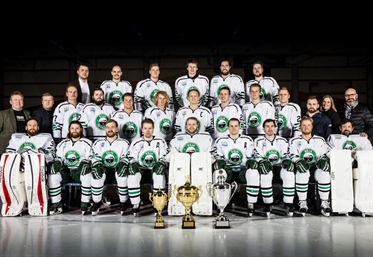Hopeful newcomers
Hopeful newcomers
Continental Cup debut for Iceland

 Esja Reykjavik, Iceland's historical first-time participants at the Continental Cup. Photo: Kristjan Maack
Esja Reykjavik, Iceland's historical first-time participants at the Continental Cup. Photo: Kristjan Maack
Rising 914 meters above sea level and dominating the Reykjavik skyline in the world's northernmost capital is Mount Esja. A fitting name chosen by the reigning champions of Iceland who in record time climbed up to the summit of the Icelandic game.
Now entering its fourth season since the foundation of its hockey section, Esja Reykjavik has already ruffled a few feathers during their ascent towards the domestic championship title. Now they look to continue their winning ways further afield.
"We are writing Icelandic hockey history by being the first team to play in the Continental Cup and now we want to make a name for us on the European hockey map," said the club's Chairman Gunnar Arnason as he sets out the lofty ambitions for the team ahead of 2017/18.
"We have a really strong team this season, so we want to defend our domestic title and hopefully also win at least one or two games in the Continental Cup," he continued.
Pitted in Group A at the first round of the Continental Cup together with hosts Crvena Zvezda Belgrade, Irbis-Skate Sofia from Bulgaria and Turkey's Zeytinburnu Istanbul, Esja Reykjavik's success story from competing at the fringes of the Arctic circle to a bustling Balkan metropolis started back in 2014.
"For more than 20 years, there had just been three ice hockey clubs in Iceland," said Arnason referring to Bjorninn Reykjavik, SR Reykjavik, and SA Akureyri from Iceland's northern part."In order to meet the requirements to play at the World Championships there were both A and B teams competing in our league. I know many great players who decided to quit the game because of playing the same teams over and over again," he said.
In an attempt to try and break the monotony Esja Reykjavik's hockey section saw its light. A previous attempt in Icelandic hockey had seen a new team named Narfi compete at the bottom of the championship between 2004 to 2007 before folding. Esja Reykjavik's ambitions appeared loftier right from the outset.
One player answering the new team's call right from the outset was Petur Maack. The national team player decided to shift allegiances and dressing rooms within the Laugardalur Arena in Reykjavik where the new boys were to share facilities with SR Reykjavik.
"It was a tough decision;" said Maack. "Except for a couple of years spent in Sweden I played my whole career for SR. But I was tired of playing in a league with only three teams and I thought joining the newly formed Esja it would be a great opportunity to help expand the league and give younger players bigger roles in other teams."
Running out of steam at the end of their matches became a recurring theme throughout their first season. They then improved considerably during the 2015/16 season reaching the play-offs, before things fell into place last season. With only two defeats in their 24 regular season matches, Esja Reykjavik then steamed ahead to topple record champions Akureyri in three straight matches at the final series.
The formula for the swift success towards hoisting the championship trophy in March 2017 is explained by the club's chairman Arnason:
"We spend most of our budget on domestic players as they are a rare commodity. We have better domestic players than the other teams and also a great group of people working around the club," he said.
With a population of 334,000, Iceland's recent international success in football, handball, and basketball has been credited to the numerous top-end facilities available at your doorstep. In the capital region of Reykjavik, ice hockey is facing an uphill struggle with its two congested indoor rinks in the metropolitan area for long having been a concern for the continued prosperity of the game.
"We need more rinks and we would have needed them already yesterday. In our rink which we are sharing with SR Reykjavik who has 300 players of all ages, but also another figures skaters of almost 300 and it is also open for public skating to generate income," said Arnason.
"We don't have any junior development as there is no ice time available, which is really sad as we would like to start right away and build up our own players instead of taking them from other clubs," said Arnason, uncertain of what will be looming around the corner.
"We don't know how the future looks. We cannot play each year without junior development. If we don't get ice time for the kids within one or two years I think we will have to throw in the towel because it doesn't make any sense to run the club without the kids," he said.
So there will be plenty to play for as Esja Reykjavik steps out on the Pionir Ice arena in Belgrade for their Continental Cup debut, in what will be familiar surroundings to many of the Icelandic national team players.
"I have been to Serbia twice playing for Iceland at the World Championships. I enjoyed playing in the Pionir rink in Belgrade in 2014 and it was 2009 in Novi Sad where I as an 18-year-old made my first appearance for the senior national team," said Maack who is now set to play his part in a new chapter of Icelandic ice hockey folklore in the Continental Cup.
"We are preparing for three hard back to back games. I don‘t know a lot about the other teams except for the Serbian team. Having played against most of their players at the World Championships they have been hard contenders, but we feel prepared," said Maack.
Back to Overview
















































